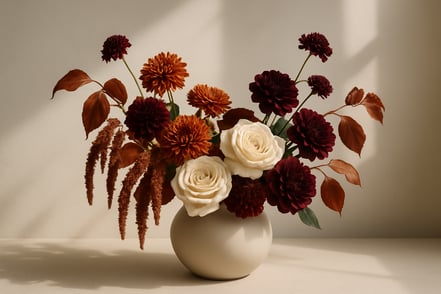Creativity is the beating heart of every successful flower shop. It’s what draws customers to your designs, sets your shop apart from competitors, and makes your work deeply fulfilling. But when the day-to-day demands of running a business take over, creativity can sometimes get lost in the shuffle. How do you keep your creative edge while managing production, customers, and inventory?
The answer lies in breaking creativity down into its building blocks—color, shape, texture, and space—and intentionally incorporating those elements into your designs. Whether you’re training a new team member or reigniting your passion for design, mastering these creative fundamentals can breathe new life into your work.
Color: More Than Just Pretty Hues
Color is often the first thing customers notice, and it’s one of the most powerful tools in your creative toolbox. But truly creative color decisions extend beyond matching blooms to a ribbon or using the same palette every season.
Start by exploring color in new ways. Try a monochromatic scheme, like all-whites or all-pinks, to highlight texture and structure. Use complementary colors—those opposite on the color wheel—to create striking contrast. Or build a design around analogous tones, like coral, peach, and blush, for a soothing, harmonious look.
Don’t forget about the psychology of color. Reds and oranges feel bold and energetic, while blues and purples are calming and elegant. Consider the emotional tone of your arrangement and choose your palette with intention.
When planning your week, build designs that showcase trending or seasonal palettes and give your team opportunities to experiment within those boundaries.
Shape & Form: The Foundation of Style
Every floral design has a shape—even if it’s abstract. Understanding the lines and movement within a design helps you control its impact and tell a story.
Classic shapes like round, triangular, or crescent are foundational for everyday arrangements. Asymmetrical shapes add drama and work well for contemporary or event work. Line designs using tall or spiky elements offer height, drama, and elegance with fewer flowers.
Encourage your team to study shape and form deliberately. Have them sketch a design before building it to practice movement and negative space. Working with structure first allows more freedom later and helps newer designers gain confidence.
Texture: The Secret Ingredient
Texture is what makes a design feel rich and layered. It’s created through the interplay of soft petals, shiny foliage, sturdy stems, delicate accent flowers, and architectural elements.
Combining textures can take a simple bouquet from flat to fabulous. Pair smooth calla lilies with fuzzy dusty miller, or mix waxflower with curly willow. Use contrast to draw the eye, such as rough bark against glossy foliage or dense clusters next to airy spaces.
Texture isn’t just visual—it’s tactile too. It affects how an arrangement is perceived by the person receiving it. Designs with lush, varied textures often feel more luxurious and captivating, even if the stem count is modest.
Challenge yourself and your team to design arrangements that focus on texture as the primary design element at least once a week.
Using a simple framework of color, shape, texture, and space helps our team make bolder design choices and keeps creativity part of every shift. We schedule short weekly play sessions so ideas stay fresh, and those small habits make a big difference here in Huntington, NY.
- Kasey Shi, Queen Anne Florist & Flower Delivery
Space: Breathing Room for Beauty
One of the most underrated elements of design is space. Leaving intentional gaps between blooms or branches gives each flower room to shine and creates a sense of sophistication and drama.
Incorporating negative space is especially important in premium arrangements, where you want every element to feel intentional and high-end. Resist the urge to fill every gap. Let certain flowers “float” for a more dynamic and airy feel. Think of “rests” in music; they make the notes more pronounced and special.
Practice spacing by designing with fewer stems and focusing on placement. Use branches or long-stemmed foliage to establish the framework, then strategically insert focal blooms. Space creates contrast, and contrast creates interest. This is especially important when incorporating flowers like protea, and tropical flowers in a design. They need their space to shine.
Keeping Creativity Alive
Building creativity into your daily workflow doesn’t require major changes. Set aside time each week to play with new ideas. Host design challenges with your team or test new techniques with leftover flowers. Use social media trends, seasonal materials, or even customer requests as a jumping-off point for experimentation.
Remember, creativity isn’t a luxury—it’s the fuel that powers your brand and keeps customers coming back for more. By focusing on the fundamental elements and principles of design, you can keep that creative spark alive, even in the busiest of seasons.
6/18/25 4:40 PM
.png?width=89&height=50&name=Blog%20Design%20(1).png)


